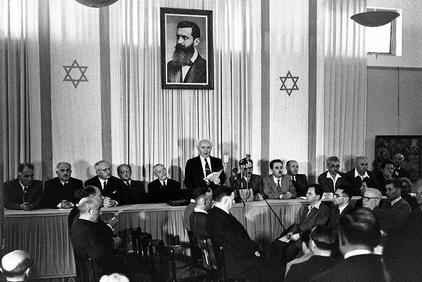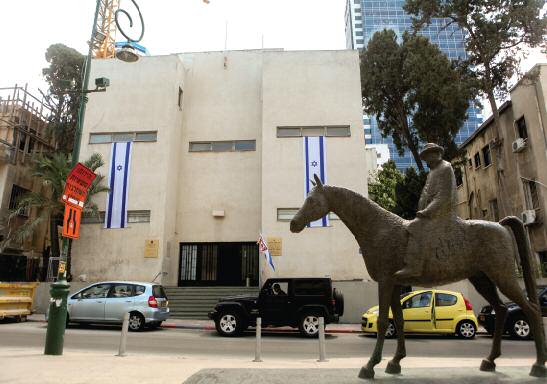On and Off the Beaten Track at… Independence Hall
In the following piece, tour guide Peter Abelow describes several tourist sites that are ideal to visit to commemorate Israel’s Independence Day including Independence Hall.
The aspirations of our people to return home and re-establish Jewish independence in the Land of Israel, preserved tenaciously through 2,000 years of galut, came to a dramatic climax in a small museum on Rothschild Street in Tel Aviv at 4 pm on a Friday afternoon, May 14, 1948.
The story of the historic building which became Israel’s Independence Hall is almost as compelling as the events that transpired within its walls on that fateful afternoon. On April 11, 1909 (20th day of Nisan), sixty-six families had gathered at that very spot, lot #43, then a sandy dune near the Mediterranean, to determine the distribution of the lots which would make up one of Tel Aviv’s first neighborhoods. Sixty-six white sea shells with the lot numbers and sixty-six dark sea shells on which the names of the families had been inscribed were picked by one of the children, one at time, from each pile. Meir Dizengoff and his wife, Zina, who were among the leaders of this pioneer group, “won” lot #43.
The Dizengoffs built their home, as did the others, and the neighborhood of Ahuzat Bayit began to take shape, as well as the Herzliya Hebrew Gymnasium, the first school in modern Israel where Hebrew was to be the language of instruction. Meir Dizengoff went on to become the head of the neighborhood committee and then the first mayor of the new Jewish city, now officially named Tel Aviv. Renowned personalities from every walk of life visited the house on lot #43 to call upon Meir Dizengoff: Winston Churchill, Albert Einstein and Chaim Nachman Bialik, to name a few. When Zina died in 1930, Meir donated his home to the City of Tel Aviv for the creation of an art museum. He could not possibly have envisioned that a mere eighteen years later, his home would become the focus of world attention.
On November 29, 1947, the General Assembly of the newly constituted United Nations voted to partition the British Mandate of Palestine and authorize the creation of a Jewish state. Despite the untenable borders of the “Partition Plan,” including the fact that most of what had been allocated to the Jews was desert in the Negev, and the painful reality that Jerusalem was to be an international city in the heart of the Arab zone, the decision was greeted with rejoicing in the Jewish world. However, as we prepared to declare statehood, our enemies prepared to declare war. The Arab response was a renewal of acts of terror and violence against Jews throughout Palestine. On the very next day, November 30, Arabs attacked a convoy of Jewish vehicles on the way to Jerusalem. Israel’s Milchemet Ha’atzmaut, War of Independence, had begun.
At 4:32, Ben-Gurion banged the gavel and the ceremony was over. The modern State of Israel was born.
Six months later, on May 15, the British formally withdrew from Palestine. The Mandate was over. But May 15 was a Shabbat, so the Jewish leadership decided to declare independence on erev Shabbat, May 14, at 4 pm. The ceremony was to take place at the Dizengoff Museum on Rothschild Boulevard. Many members of the Provisional State Council (temporary legislature of Israel from shortly before independence until after the election of the first Knesset) were stuck in Jerusalem, besieged by Arab forces, but the others assembled in the large gallery on the lower level of the museum. Chairs for the 400 invited guests had been borrowed from local cafes; a podium had been hastily constructed and a sound system, also borrowed, stood ready to broadcast the dramatic moment.
Although the full invasion by the surrounding Arab nations was not to take place until the following day, fighting was already raging all over the country. Since most of the leaders of the Yishuv were to be assembled in one spot and a bombing by the Egyptian Air Force was feared, it was decided not to reveal the details of the ceremony. The 400 formal invitations stated, “Please keep the time and place of the ceremony a secret.” They kept the secret so well that by 3:00 pm the streets were jammed and the couriers who were bringing the text of the Declaration to the hall had to battle their way through the crowds to get to the building.
The ceremony began precisely at 4 and, with the world listening intently, David Ben-Gurion read the Declaration of the Establishment of the State of Israel:
Accordingly we, members of the People’s Council, representatives of the Jewish Community of Eretz-Israel and of the Zionist Movement, are here assembled on the day of the termination of the British Mandate over Eretz-Israel and, by virtue of our natural and historic right and on the strength of the resolution of the United Nations General Assembly, hereby declare the establishment of a Jewish state in Eretz-Israel, to be known as the State of Israel.
(Translation provided by http://www.knesset.gov.il/docs/eng/megilat_eng.htm)

David Ben-Gurion reading the Declaration of the Establishment of the State of Israel on May 14, 1948 in the Dizengoff house in Tel Aviv. To Ben-Gurion’s right is Rabbi Yehuda Leib (Fishman) Maimon.
Photo: The State of Israel National Photo Collection/Kluger Zoltan
At 4:32, Ben-Gurion banged the gavel and the ceremony was over. The modern State of Israel was born.
I strongly encourage readers to take a few minutes to read the entire text of the Declaration (http://stateofisrael.com/declaration/). It underscores the historical context of our right to the Land of Israel and the world’s acknowledgment of that right, messages which are sometimes overlooked in today’s discussions. It also sets the vision for what our country should ideally represent. The penultimate paragraph calls for “Jewish people all over the world to rally to our side in the task of immigration and development and to stand by us in the great struggle for the fulfillment of the dream of generations—the redemption of Israel,” a message that resonates as much today as it did then.
A visit to Independence Hall begins with a short film about the Dizengoff house and the story of the birth and growth of Tel Aviv. After that, you will be led by one of the excellent guides to the room where the ceremony took place. You will then be magically transported back to that Friday afternoon, while listening to a recording of David Ben-Gurion’s voice, from the actual ceremony. You will hear the quivering voice of Rabbi Yehuda Leib (Fishman) Maimon reciting the Shehecheyanu as well as a recording of the Hatikvah that was played that day by the orchestra assembled in the loft above (there was no room for them in the main hall). Like most visitors, you will probably have tears in your eyes at this point. There is no more moving way to connect with the dramatic moment of modern Israel’s birth than a visit to Heichal Ha’atzmaut, Independence Hall.
The museum is located at 16 Rothschild Boulevard in Tel Aviv. Tours must be reserved in advance. Call (03) 510.6426 or (03) 517.3942 for reservations.
Peter Abelow is a licensed tour guide and the associate director of Keshet: The Center for Educational Tourism in Israel. Keshet specializes in creating and running inspiring family and group tours that make Israel come alive “Jewishly.” He can be reached at 011.972.2.671.3518 or at peter@keshetisrael.co.il.

